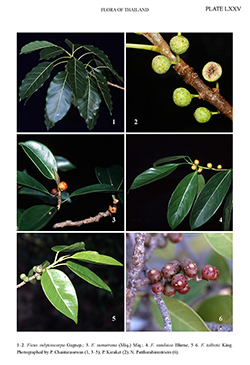e-Flora of Thailand
Volume 10 > Part 4 > Year 2011 > Page 643 > Moraceae > Ficus
URO39. Ficus sumatrana (Miq.) Miq.wfo-0000690514
Ann. Mus. Bot. Lugd. Bat. 3: 263, 287, t. 10B. 1867; King, Ann. Roy. Bot. Gard. (Calcutta) 1(1): 40, t. 35B. 1887; Kochummen, Tree Fl. Malaya 3: 158. 1978; Kochummen, Tree Fl. Sabah & Sarawak 3: 223. 2000; C.C.Berg & Corner, Fl. Males., Ser. 1, Spermat. 17(2): 682. 2005.— Urostigma sumatranum Miq., Pl. Jungh.: 49. 1851. Plate LXXV: 3.
Accepted Name : This is currently accepted.
Synonyms & Citations :
Description : Tree to 20(–)30 m tall, hemi-epiphytic, (secondarily?) terrestrial, or lianescent (?). Branches drying brown to greyish. Leafy twigs 1.5–4 mm thick, ± angular, glabrous (minutely) white puberulous; periderm persistent. Leaves spirally arranged; lamina oblong to elliptic, (2–)4–19 by 1.5–9 cm, coriaceous, apex acuminate to subacuminate, the acumen acute (or obtuse), base rounded, obtuse or cuneate, margin flat or slightly revolute towards the base; upper glabrous or minutely white puberulous on (the lower part) of the midrib, lower surface glabrous or (minutely) whitish puberulous on the midrib or also on the lateral veins; midrib ± impressed or flush above, lateral veins (2–)4–7(–9) pairs, the basal pair to ⅙–½(–⅔) the length of the lamina, often (faintly and) sparsely branched, departing the midrib 2–5 mm above the base of the lamina, 0–1 pairs of smaller lateral veins below the main pair, tertiary venation reticulate to largely parallel to the lateral veins, almost flush to prominent; waxy gland at the base of the midrib; petiole 0.8–2.5(–4) cm long, 1–2.5 mm thick, glabrous, drying blackish to brown, sometimes with a waxy layer; stipules 1–1.5(–2.2) cm long, often with a distinct median part, densely (to rather sparsely) whitish to yellowish (sub)sericeous to (minutely) puberulous (mainly on the thickened median part) or glabrous, caducous. Figs axillary, sessile; basal bracts 3, 2–5(–7) mm long, (sub) equal, often 1 (or 2) with a distinct median part or (faintly) keeled, whitish puberulous (on the whole outer surface or only on the median part) or glabrous; receptacle subglobose to depressed globose, 0.3–0.8 or 0.8–1.3 cm diam. when dry, glabrous or minutely white puberulous, yellow to red at maturity, apex (slightly) convex, ostiole 1–4 mm diam., slightly prominent (to flat), closed, the 3 upper ostiolar bracts fully imbricate; wall smooth or ± shrivelled (except for the apical part) when dry; internal hairs absent. Tepals red to pinkish. Ovary partly red (or entirely whitish).
Thailand : NORTHERN: Chiang Mai; SOUTH-WESTERN: Phetchaburi (Kaeng Krachan); SOUTH-EASTERN: Chachoengsao, Trat (Ko Kut); PENINSULAR: Ranong, Phangnga, Phuket, Nakhon Si Thammarat, Phatthalung, Trang, Songkhla, Narathiwat.
Distribution : Burma, Laos, Vietnam, Cambodia, Peninsular Malaysia and Bornean Malaysia, Singapore, Bornean Malaysia (Sarawak), Indonesia (Sumatra – type, Java, Kalimantan, Sulawesi?), the Philippines.
Ecology : Evergreen and dry evergreen forests, at low altitudes.
Vernacular : Sai krang (ไทรกรัง)(Rayong).
Notes: As indicated in the Flora Malesiana treatment of this species, several forms can be distinguished without clear circumscriptions due to the presence of intermediates. The distribution of the morphological groups of specimens does not help either to formalize the differences, which can be quite prominent in regions such as Thailand. The following forms can be recognised in Thailand:
a. White (minutely) puberulous to subtomentose on the stipules, and mostly also the leafy twigs, the basal bracts, or also the petiole and midrib of the lamina beneath. Lamina with 4–6(–7) pairs of lateral veins, the basal pair mostly 1/4–1/3 the length of the lamina: petiole and stipules often longer than 1.5 cm, the former to 3(–3.5) cm, the latter to 2.5 cm long. Basal bracts (4–)5–8 mm long, fig receptacle (0.6–)0.8–1(–1.3) cm diam.
This form comprises the types of Urostigma monadenum, U. pseudorubrum, U. zollingerianum, Ficus rigida (Miq.) Miq. var. trichocalyx Valeton, F. pseudoacamptophylla, and F. sumatrana var. circumscissa Corner, and also numerous specimens which have been previously identified as F. subgelderi Corner var. rigida (Miq.) Corner. It ranges from Vietnam and Laos through Thailand to the Malay Peninsula, Sumatra, Java, and Borneo (Sarawak). It is the most common form of the species in Thailand where two subforms can be distinguished:
a’. Apex of lamina acuminate and the acumen (sub)acute, in Thailand represented by van Beusekom et al. 718 (Phangnga), Geesink et al. 4902 (Ranong) and 6604 (Trat), Larsen et al. 33454 (Ranong), Koyama et al. T-33902 (Ranong), and Santisuk 1244 (Ranong).
a”. Apex of lamina shortly (sub)acuminate and the acumen obtuse, represented by Kerr 2743, 16558 (Nakhon Si Thammarat), 17440 (Phuket), and occurring elsewhere in the species range.
b. Glabrous in all parts, but in other features similar to a’. It is represented by the type of Ficus subsumatrana (from Vietnam) and probably also by the (unseen) type of Urostigma rigidum (from Peninsular Malaysia). It is known by a single Thai collection, Parnell et al. 95-508 (from Phetchaburi), some collections from the Malay Peninsula and N Sumatra. This form passes more or less clearly into a northern Bornean form (in Flora Malesiana indicated as Form B).
c. Glabrous (or nearly so) in all parts and these smaller than in form b: petioles and stipules mostly to 1.5 cm long; basal bracts 3–5 mm long; fig receptacle mostly 0.3–0.8 cm diam. This form comprises Ficus sumatrana var. microsyce and F. dulitensis. It ranges from Vietnam and Thailand through the Malay Peninsula to Sumatra (Banka), Borneo and the Philippines. The ostiole is sometimes open in this form, but in none of the Thai collections.
Further investigation throughout the range of the species is needed to figure out whether the currently (and also for Flora Malesiana) adopted concept of the species can be maintained.

